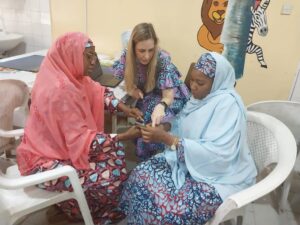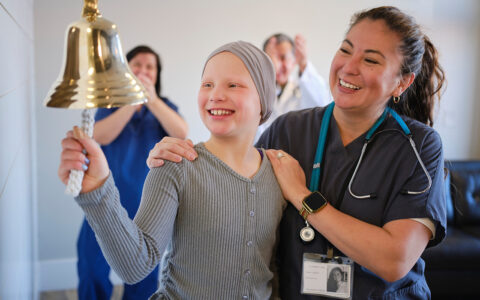Children with sickle cell disease (SCD) have an increased risk of malnutrition stemming largely from insufficient food intake to account for their higher energy requirements.
In areas of the world lacking adequate resources such as sub-Saharan Africa, about 45 percent of all deaths in children under age 5 can be at least partially attributed to malnutrition.
“The really young kids are the ones who get all the attention; what we wanted to know is if children over 5 are also at increased risk of death,” said Lauren Klein, M.D., a pediatric gastroenterologist at Monroe Carell Jr. Children’s Hospital at Vanderbilt.
In a series of studies published in Blood Advances, Klein and a team of researchers show that underweight is associated with mortality in children from low-resource areas with SCD from age 5 up to 12 years. They explore the risk factors for underweight in both low- and higher-resourced settings, and test the feasibility of outpatient treatment for uncomplicated severe acute malnutrition in children 5 to 12 with SCD.
Connecting to Africa

While completing a fellowship in the Division of Pediatric Gastroenterology, Hepatology and Nutrition at Vanderbilt University Medical Center, Klein’s division chief and fellowship director Sari Acra, M.D., introduced her to Michael DeBaun, M.D., director of the Vanderbilt-Meharry Center of Excellence in Sickle Cell Disease. DeBaun encouraged Klein to apply for the Vanderbilt-Emory-Cornell-Duke Fogarty Global Health Fellowship in Ghana, West Africa, focused on maternal nutritional status and risk of adverse birth outcomes in undernourished mothers with SCD.
These mentors became Klein’s co-investigators in the SCD malnutrition studies.
“I’m so fortunate to be able to pursue my passion for this work here at Vanderbilt,” she said.
Most of the participant data for the studies was drawn from the Primary Prevention of Stroke in Children with Sickle Cell Disease in Sub-Saharan Africa II (SPRING) trial, led by DeBaun and colleagues from Aminu Kano Teaching Hospital and Friends in Global Health-Nigeria.
“When Dr. DeBaun was conducting the stroke trial, they noticed that many of the children suffered from malnutrition. Now I am working with the team delving deeper into the causes of this malnutrition,” Klein said.
Importance of Age and Weight
The team’s first study looked at children aged 5 to 12 from the SPRING trial. Nutritional status was classified as underweight (weight-for-age z score), stunting (height-for-age z score) and wasting (body mass index z score). Children who died during the study, on average, had a lower mean weight-for-age z score than those who survived, although their other baseline characteristics were similar to those who survived.
“These kids are coming from very different landscapes, but what we’ve found is that being older puts you at risk for being underweight, as well as low hemoglobin.”
Based on these findings, a second study compared children 5 to 12 from the SPRING trial with a similar cohort from the Silent Cerebral Infarct Trial, conducted in North America and Europe. The aim was to determine the risk factors for underweight.
A total of 87.9 percent of participants in the SPRING trial met the study criteria for being underweight, and 22.7 percent for severely underweight – significantly higher than the Silent Cerebral Infarct (higher-income) cohort at 25.7 percent underweight and 0.7 percent severely underweight.
“These kids are coming from very different landscapes, but what we’ve found is that being older puts you at risk for being underweight, as well as low hemoglobin,” Klein said.
During her fellowship, Klein helped lead a randomized controlled trial for children with SCD and severe acute malnutrition in Nigeria – the first trial to look at using therapeutic food to address malnutrition in SCD.
Children with SCD and uncomplicated severe acute malnutrition were randomly assigned to receive supplemental ready-to-use therapeutic food with or without moderate-dose hydroxyurea therapy. Adherence was high for both hydroxyurea (94 percent) and therapeutic food use (100 percent). No refeeding syndrome or myelosuppression occurred, demonstrating the feasibility, safety and potential of outpatient intervention in this setting.
Bringing the Research Home
With a new Vanderbilt Faculty Research Scholars Program award, Klein hopes to conduct another feasibility trial to understand specific amino acid needs in children with SCD and eventually build a better therapeutic option.
“We hope through reverse implementation to use what we learn to help children with sickle cell disease here at home.”
Today she’s become the mentor, overseeing trainee studies in how SCD is impacted by maternal depression, food insecurity and other social drivers of health.
“Malnutrition is certainly more common in low-income areas like sub-Saharan Africa, but we know that it exists among children with sickle cell disease in the United States,” Klein said. “We hope through reverse implementation to use what we learn to help children with sickle cell disease here at home.”





